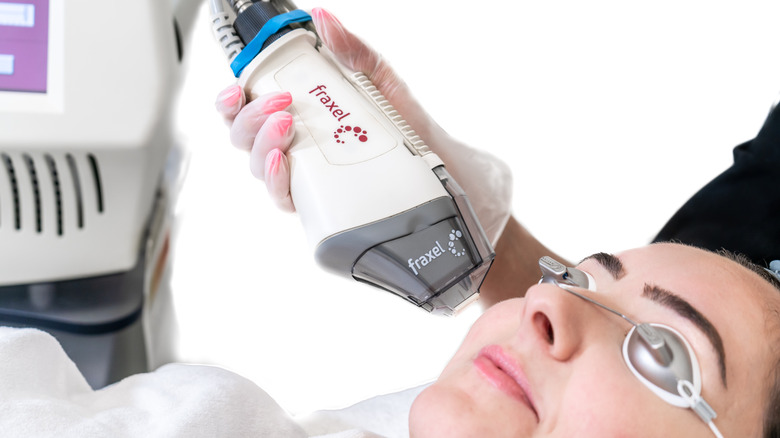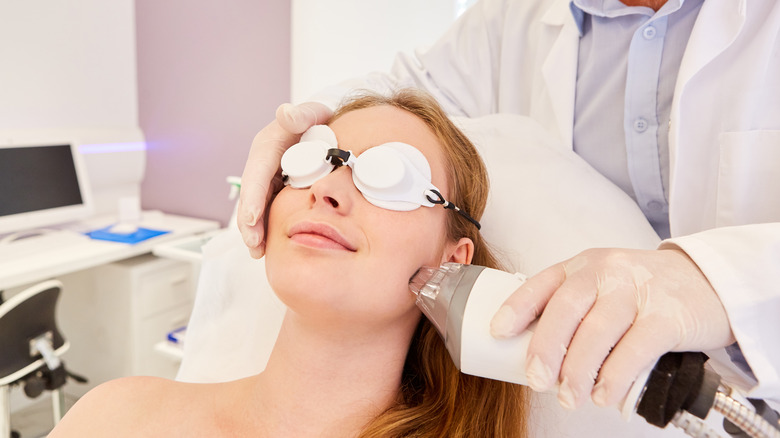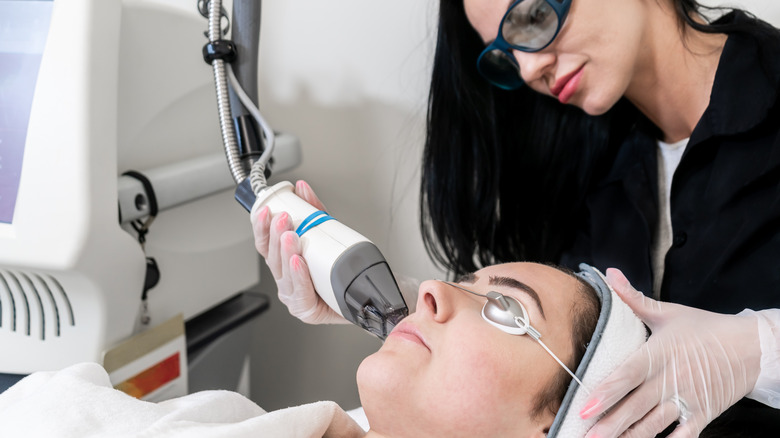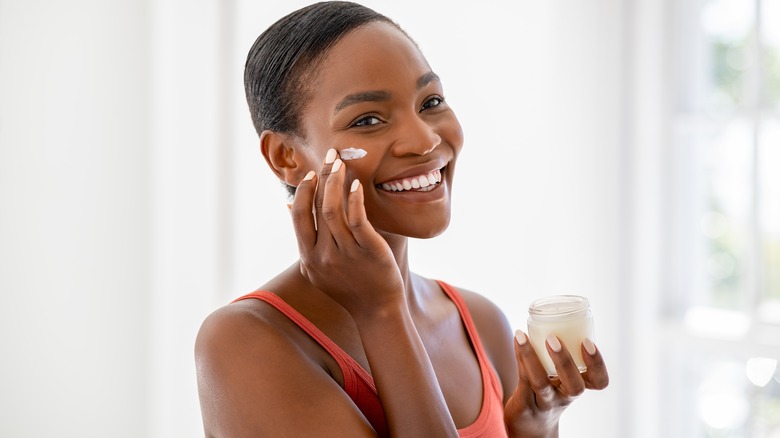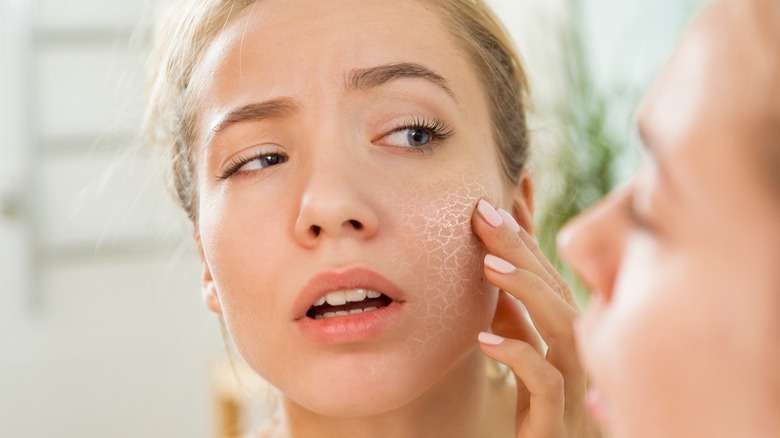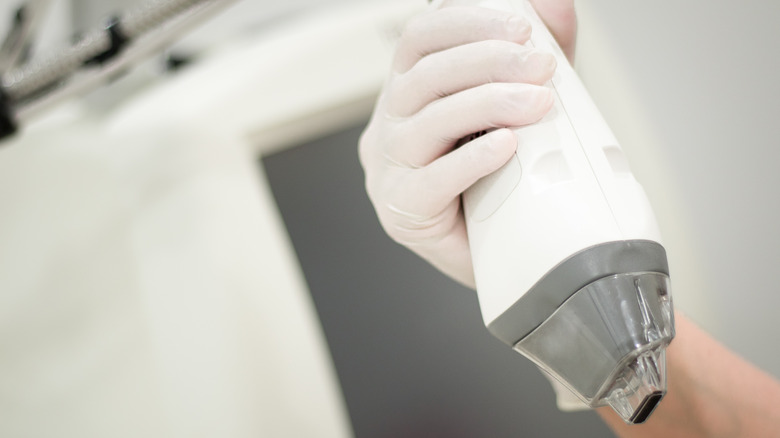What To Expect When You Get Fraxel
In the world of filters and photoshop, we all rightfully wonder whether celebs' flawless complexions are the real thing, but as it turns out, there are treatments available that can give you the skin of your dreams. Enter: Fraxel. This laser treatment yields results that are nothing short of miraculous — even dermatologists can't stop raving about it.
What is Fraxel? "It's the only device I've seen in my career that can do a little bit of everything effectively," cosmetic dermatologist Paul Jarrod Frank, M.D., tells Shape, adding, "I'd tell my patients to invest in a yearly Fraxel treatment over a slew of expensive anti-aging products any day."
That's a bold statement, but Fraxel has the ability to reach the deeper layers of your skin, effectively encouraging collagen formation and sending pigmentation packing. Dermatologist Anne Chapas, M.D., says (via Shape) that skin also tends to recover much faster from Fraxel than from other laser treatments. Virginia Oral, Facial & Implant Surgery explains that Fraxel laser treatments are non-ablative, which means that instead of demolishing the top layer of your skin like ablative lasers, it produces heat in the deeper layers of your skin, leaving the surface completely unharmed. The laser tricks the skin into thinking it has been injured, and collagen is produced to repair it. The result is firm and smooth skin. Discover everything you need to know before trying this treatment yourself.
You can choose between different types of Fraxel treatments, depending on your needs
Fraxel is a pretty versatile treatment, which means it can tackle plenty of your beauty concerns. There are two different laser wavelengths dermatologists can use when they treat your skin, depending on the skin issues you're trying to address. "The 1,927 nm [nanometer] wave-length treats the skin's superficial epidermis layer to help resolve discoloration, while the 1,550 nm wavelength targets the lower dermis level, which improves texture by fading deep lines and scarring," dermatologist Anne Chapas, M.D., tells Shape. Dermatologists can also tweak the wavelengths within those two settings to adjust them for each patient's skin.
According to Aedit, there are two types of Fraxel treatments: Fraxel Dual and Fraxel Repair. Fraxel Dual is the non-ablative sort, featuring the two wavelengths Chapas mentioned. If you're looking to use Fraxel to treat more serious skin conditions like deep wrinkles, scars, and laxity, the Fraxel Repair option will be more your jam. Be aware, however, that this treatment is ablative, which means it will actually wound the surface of the skin, leading to a longer recovery period. Healthline notes that dermatologists can utilize different Fraxel settings to treat various areas of your skin, which is a great perk, especially if certain areas need a little more TLC than others.
Keep in mind that not everyone is a great candidate for this treatment
While Fraxel can be a miracle treatment for some, it can do more harm than good for others. Whether or not you're a good candidate depends on a few things. Virginia Oral, Facial & Implant Surgery warns that if you suffer from any acne breakouts before an appointment or have skin that is incredibly sensitive, you need to stay away from Fraxel treatments.
Speaking to Healthline, board-certified dermatologist Dr. Estee Williams explains that other skin conditions, like rosacea and eczema, also won't react kindly to Fraxel treatments. Those who have a darker skin tone might also want to steer clear of more potent Fraxel treatments because the lasers can potentially cause other skin issues like pigmentation. Williams notes, however, that opting for very gentle Fraxel lasers, in this case, is an option, but you need to keep in mind that it will take much longer for you to see results.
If there are some skin concerns you'd like to address with Fraxel, it's important that you make an appointment with an experienced doctor. They will take a look at your skin and gauge whether you're a good candidate for the treatment. They'll also be able to tell if your skin won't respond well, saving you money and additional skin issues in the process.
Fraxel benefits the skin in many ways
There's a reason dermatologists can't stop talking about this laser treatment: It really works. Ultimate Image Cosmetic Medical Center calls Fraxel the singular go-to procedure for a myriad of skin concerns. Got wrinkles and fine lines you'd like to get rid of? Fraxel will do that. Have scars that you'd love to make less visible? Fraxel can do that too.
Coco Ruby Skin & Anti-Ageing explains that Fraxel can work wonders to give skin back its youthful glow. If you're struggling with skin that looks dull, Fraxel can help refresh and rejuvenate your complexion. It can also specifically be utilized to treat any mild acne scarring you might have. Fraxel works well to prevent excess scar tissue from growing after certain surgeries, if you get treatment in time — this can be a real game-changer for some. Other skin conditions like pigmentation that formed due to sun damage can be addressed with Fraxel as well. Additionally, Fraxel can help reduce textured skin and treat actinic keratosis (a condition caused by the sun that results in skin that forms scaly and dry patches).
In short: There's almost nothing Fraxel can't fix, so if you're dealing with any of the above-mentioned skin concerns, it's worth it to speak to your doctor about whether the treatment might be a good option for you.
Is Fraxel a safe treatment?
Willingly letting someone injure your face with lasers can sound somewhat daunting and even a little crazy. After all, you only have one face, and subjecting it to lasers can seem a very risky thing to do. Fraxel, however, when done by a qualified professional, is completely safe. Speaking to Healthline, assistant clinical professor of dermatology at Yale New Haven Hospital, Deanne Mraz Robinson, M.D., explains that Fraxel pretty much has a spotless record. However, how much you risk your skin depends on the doctor you choose and how well you take care of your skin before and after the treatment.
Not following the aftercare instructions to a T can lead to unwanted complications, especially if you opt for ablative Fraxel warns Mraz Robinson. "Sometimes it's better to do multiple treatments on lower settings with less downtime and less risk than doing fewer treatments on higher, more intense settings with more downtime and risk," plastic surgeon David Shafer, M.D., explains (via Healthline).
Mraz Robinson adds that Fraxel is not typically safe for those who have a tendency to develop hypertrophic or keloidal scarring. If you have vitiligo, she recommends you steer clear of this procedure. She also notes that people who have darker skin are usually more prone to developing these conditions, so again, it's imperative you discuss the treatment with your dermatologist first before proceeding.
How to prepare for a Fraxel appointment
While Fraxel works hard to restore the skin to its former glory, it does require a few things from you, too. The Dermatology Institute of Southern California notes that there are a few key steps you need to take before getting treatment to ensure it is as successful as possible (and have as few as possible side effects). Don't worry, though — it isn't complicated or super intensive.
First, you'll need to ditch any acne treatments at least three weeks before your appointment. Yup, we know, but just keep imagining the flawless skin you will eventually have from Fraxel after a few sessions. If you use any retinoids like Retin-A or other forms of retinol, it's important you steer clear of them to ensure Fraxel is successful. You should also take care to stay out of the sun before your appointment — skin that recently got a tan is not a great candidate for the treatment, and it might mean that you'll need to reschedule your appointment, and no one wants that. Skip your morning coffee and any other caffeinated drink on the day of the treatment. And last, but not least, it's very important that you inspect your face to make sure you don't have any pesky breakouts, infections, or open sores on your skin. If you do, you need to steer clear of Fraxel until your skin has cleared up.
Here's what to expect during the Fraxel procedure
Getting Fraxel for the first time can be pretty daunting, but knowing what to expect can make it a lot less nerve-wracking, so here's the lowdown.
First, make sure you're on time. Coco Ruby Skin & Anti-Ageing explains that the doctor will apply a numbing cream to your skin as soon as you arrive. It takes time for the cream to work properly (about an hour), so being on time is a must. This is kind of obvious, but we'll mention it anyway: Ditch your makeup for the day. It'll have to be removed for the procedure anyway, so not putting any on will save the doctor some time (and hopefully help you to be on time if you have a tendency to be late).
Once the doctor removes the numbing cream, your skin is ready for the procedure. For some treatments, a gel is applied to your skin. Dermatologist Jeanine Downie, M.D., tells Shape that the dermatologist will use a handpiece to administer Fraxel. They will guide it along the areas you specifically want to treat, or your entire face if that's what you desire.
It usually takes 10-15 minutes to treat one section of the skin. All in all, the treatment might last for up to an hour. If you're only treating a specific area, you might only be subjected to the laser for 10-15 minutes.
Expect to experience some mild discomfort during the treatment
One thing we all want to know when we go for a treatment like this is whether it will hurt or not. In the case of Fraxel, it really depends on your individual pain threshold.
According to Ultimate Image Cosmetic Medical Center, most people actually don't experience any pain at all. But you can expect to feel some discomfort, at the very least. The Fraxel device generates quite a bit of heat that might feel pretty intense. The numbing cream helps keep this sensation toned down as much as possible, and in addition, the dermatologist will blow cold air onto your skin while administering Fraxel to make sure your skin feels as comfortable as possible. Not too shabby, right?
But what if you don't have that great a pain threshold and even looking at that Fraxel device already makes your skin ache? Well, dermatologist Jeanine Downie, M.D., shares with Shape that the most pain you can expect to feel is the sensation that someone is snapping a small rubber band against your skin. Painful? Kinda. So bad that you can't stand it? Not likely. So, rest easy. You can expect mild discomfort at best. Of course, if the pain is intense, tell your doctor immediately.
Here's how your skin will react after Fraxel
The aftereffects of Fraxel can be a little scary, but knowing what to expect can save you from freaking out over something that's completely normal post-treatment.
"Immediately afterward you'll experience redness and some swelling, but the swelling will go down by the next day," dermatologist Jeanine Downie, M.D., shares with Shape. She adds that you can also expect to see a brownish-red tone for multiple days. Schweiger Dermatology Group notes that some oozing or crustiness on your skin for the first three days after the procedure is totally normal. Four to six days after the treatment, you'll likely notice that the swelling starts to go down. Experiencing any crustiness during this time is still normal. Your skin will start to look flaky and a little pink around seven days after your Fraxel treatment. You might experience some itchiness, and it's crucial you don't scratch or pick at it. To prevent itchiness from occurring in the first place, keep your skin hydrated with a gentle moisturizer, and stay out of the sun.
What a Fraxel aftercare regimen looks like
As you might have gathered, Fraxel treatments require work from your side to be successful.
BeBeautiful cautions against using skincare containing harsh ingredients for the first week post-treatment. You'll only want to use products that are lightweight and gentle — ask your dermatologist what they recommend if you're not sure what works. You should also wash and moisturize your face twice a day and stay far away from any exfoliators — this will only make existing peeling worse.
Coco Ruby Skin & Anti-Ageing explains that your skin will look and feel as if it has been sunburned — not exactly the best sensation — but spending the first six hours post-treatment icing it for 5-10 minutes can work wonders. Just don't apply the ice straight to your face. Make a DIY compress using whole milk and ice water. The fats and lactic acid in the milk will soothe your skin. Alternatively, you can ask your dermatologist what method they recommend.
You should also stay out of the sun and apply sunscreen that has an SPF of 50 or higher. SW1 Clinic notes that steering clear of the sun and protecting your skin against it will help prevent any pigmentation from forming. Something else you need to steer clear of after Fraxel is exercise. Keep in mind that your skin will be slightly inflamed and hot to the touch. Throwing an intense workout into the mix will only make these symptoms worse, so take a few rest days.
Common side effects of Fraxel
As with any invasive treatment out there, you might experience some side effects from Fraxel. It's not a given that you'll deal with side effects, but knowing what to expect is always best.
Schweiger Dermatology assures that side effects are minimal and usually nothing to worry about. In fact, most patients don't deal with any side effects at all. We should, however, mention that there is always a small chance that you might get an infection or experience scarring after the procedure. Again, this is very unlikely to happen. Once your skin has healed up, it will return to its normal state, and you might even notice an extra glow after your first treatment.
More common side effects you might experience that are nothing to worry about include itching, swelling, redness, changes in the color of your skin, and the sensation that you've been sunburned, Ultimate Image Cosmetic Medical Center explains. If you notice anything that sets off alarm bells, like very red, angry skin that swells suddenly and is accompanied by pus and a foul smell, you should contact your doctor immediately since you might have an infection.
How soon can you expect to see results after Fraxel?
We all know that beauty treatments take time to work, but when it comes to Fraxel, you typically won't have to wait months to see the results. In fact, cosmetic dermatologist Paul Jarrod Frank, M.D., tells Shape that you'll see results from only one or two Fraxel treatments per year. He does add, however, that the results and amount of treatments you need per year will boil down to the severity of the skin concerns you're addressing. "That may mean five appointments over five months for deep scars and wrinkles. For pigmentation issues like melasma, you may need one more treatment," Frank explains.
For less severe skin concerns, you can expect to see results within a week of treatment — for real! Wrinkles and scars will look less pronounced, and you might notice that your pores appear smaller. Most people also notice a difference in the texture of their skin, and if you suffer from melasma, one treatment can cause a noticeable difference. Needless to say, this treatment is totally worth it.
How much does Fraxel cost?
Fraxel might work miracles, but it's going to cost you. The price varies depending on the type of treatment you opt for, how many you need, and where you live. Plastic surgeon David Shafer, M.D., shares with Healthline that treatments can vary between $500-$5,000. In New York City, Shafer says the average price for Fraxel is $1,500.
If you're hoping your health insurance will cover it, don't bank on it. Shafer says that Fraxel is only covered by insurance if it is a medical necessity. He adds that some of his patients have been successful in claiming Fraxel coverage from their health insurance, but you should definitely not count on it happening. Fraxel treatments can work out cheaper in the long run. If you consider the number of sessions you'll need to get the desired results and compare the cost to that of continuously buying skincare that can deliver a fraction of those results, the latter quickly becomes more expensive in the long term. Of course, in the end, the decision is up to you.
You will need multiple sessions to see the desired results
There's no doubt about it — Fraxel will give you results. Director of cosmetic and clinical research in Dermatology at Mount Sinai Hospital, Joshua Zeichner, M.D., tells Harper's Bazaar that one Fraxel session can improve your skin by about 50%. That's kind of insane.
Speaking to Aedit, board-certified dermatologist Paul Jarrod Frank, M.D., explains that the number of Fraxel treatments you need depends on a few things, most notably the patient's main skin concerns and the look they want to achieve."For people who want general resurfacing, I recommend a once-a-year treatment," Frank explains. "People with a history of skin cancer usually get it done twice a year," he adds. If you want to clear your skin of severe sun damage, Frank recommends you go for monthly Fraxel treatments two to four times. Your dermatologist will be able to gauge how many you need for your specific skin concerns.
As for how long Fraxel results last, board-certified dermatologist Amy Wechsler, M.D., (via Aedit) says you can expect that glow to remain for a whole year, sometimes even longer. Board-certified dermatologist Dendy Engelman, M.D., (via Aedit) advises patients to go for a Fraxel treatment once a year to keep their skin looking amazing.
Should you only opt for Fraxel-branded treatment?
"Fraxel is a brand name, like Kleenex or Botox," assistant clinical professor of dermatology at Yale New Haven Hospital, Deanne Robinson, M.D., tells Healthline. "[The Fraxel name] denotes fractional laser resurfacing," she adds.
So, if your favorite salon does not offer Fraxel-branded treatments, it doesn't mean you can't get it. Plastic surgeon David Shafer, M.D., (via Healthline) explains that the only thing that matters is the actual fractional technology — if your dermatologist owns this laser, they can administer Fraxel treatments even if that laser isn't Fraxel branded. He does, however, admit that the name carries a lot of weight. "[They offer] a brand recognition we understand to imply luxury, quality, and results like that of Tiffany, Ferrari, and Apple." But that fractional laser that doesn't have the word Fraxel on it won't give you inferior results, which means you can rest easy. Always make sure you go to a professional who knows exactly what they are doing, then get ready to get your glow on.

